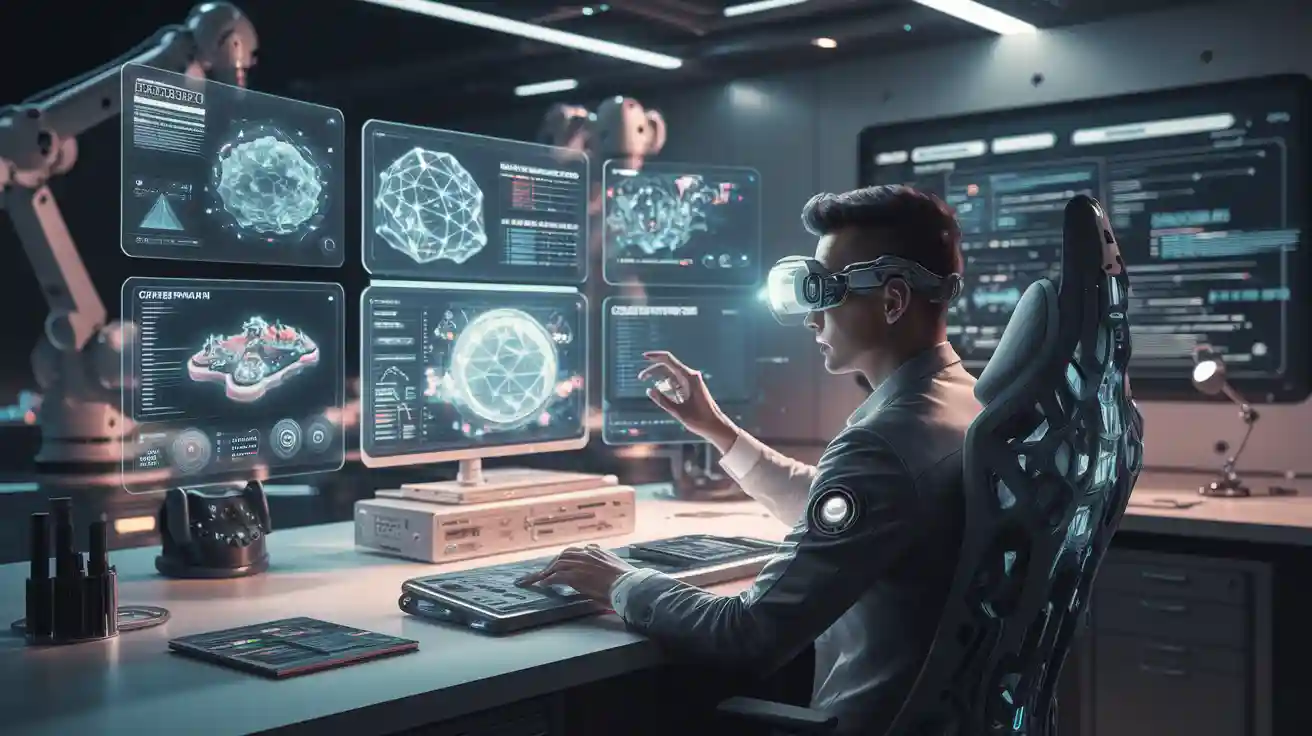
Game AI has completely transformed how you experience games today. It’s not just about controlling characters anymore. AI-driven non-player characters (NPCs) can now hold real-time conversations with you, making every interaction feel personal. Ever noticed how a game gets tougher or easier based on your performance? That’s AI adjusting the difficulty to keep you engaged. Some games even use AI to create unique levels or assets, so every playthrough feels fresh and exciting. Whether you're into coding or game development, mastering game AI opens doors to crafting these immersive experiences and building skills that shape the future of gaming.
Key Takeaways
-
Learn C++ and Python to be great at game AI. Begin with Python because it's easy, then move to C++ for faster tasks.
-
Build good problem-solving skills. Split big problems into smaller ones to solve them better in AI work.
-
Keep up with new ideas in AI and game making. Read industry news often to stay skilled and current.
The Role of a Game AI Programmer in Game Development
Responsibilities of a Game AI Programmer
As a game AI programmer, you play a pivotal role in shaping how players interact with games. Your job involves creating intelligent systems that make NPCs behave realistically, adapt to player actions, and enhance storytelling. You’ll design algorithms like finite state machines and behavior trees to give NPCs dynamic and modular behaviors. Pathfinding algorithms help characters navigate complex environments, while reinforcement learning allows AI to adapt and evolve based on gameplay.
Collaboration is key in game development. You’ll work closely with designers to implement adaptive gameplay mechanics, like dynamic difficulty adjustments, ensuring players stay engaged. You’ll also optimize AI systems for performance, making sure they run smoothly without draining resources.
Here’s a snapshot of your responsibilities:
|
Responsibility Category |
Specific Responsibilities |
|---|---|
|
AI Algorithms and Techniques |
– Creating rule-based systems for NPC behavior. |
|
Machine Learning in Games |
– Applying reinforcement learning for adaptive AI. |
|
Game Design and Mechanics |
– Collaborating with designers to enhance gameplay. |
|
NPC Behavior and Interaction |
– Developing realistic NPC behaviors. |
Importance of Game AI in Modern Gaming
Game AI is the backbone of immersive gaming experiences. It’s what makes NPCs feel alive and worlds feel dynamic. Imagine playing an open-world game where NPCs react to your choices or a strategy game where AI opponents adapt to your tactics. That’s the magic of game AI.
Modern gaming relies heavily on AI technologies like machine learning, behavior trees, and reinforcement learning. These tools create lifelike NPCs, procedural worlds, and adaptive difficulty systems. According to market studies, 73% of game studios already use AI, and 88% plan to integrate it further. AI-driven features like live translation and automated storytelling are growing rapidly, with storytelling alone seeing a 300% increase in five years.
Here’s why game AI matters:
-
It enhances player engagement through adaptive difficulty.
-
It reduces development costs by automating asset creation and testing.
-
It opens doors to innovative gameplay mechanics, like AI-generated worlds.
Career Opportunities in AI Game Programming
The demand for AI game developers is skyrocketing. Studios need skilled professionals to create engaging gameplay experiences using AI-driven techniques. If you’re passionate about coding and game development, this field offers exciting opportunities.
You’ll find roles in major studios, indie teams, and even startups. The industry supports newcomers with educational resources, certifications, and networking events. Building a portfolio with AI-driven projects can help you stand out.
AI game programming isn’t just a job; it’s a chance to shape the future of gaming. With AI transforming how games are made and played, your skills will be in high demand.
Technical Skills for AI Game Programming

Programming Languages for Game AI (C++, Python)
When it comes to coding for game AI, two programming languages stand out: C++ and Python. Each has its strengths, and choosing the right one depends on your goals.
C++ is the go-to language for high-performance game development. It compiles directly into machine code, giving you full control over memory and optimization. This makes it ideal for creating complex AI systems that need to run smoothly in resource-intensive games. However, its steep learning curve and intricate syntax can be challenging for beginners.
Python, on the other hand, is beginner-friendly. Its simple syntax and extensive libraries make it perfect for prototyping AI systems quickly. Libraries like TensorFlow and PyTorch simplify tasks like neural network implementation. While Python sacrifices some performance due to its interpreted nature, it’s highly portable and works well for smaller projects or tools that support game development.
|
Criteria |
Python |
C++ |
|---|---|---|
|
Ease of Use |
Easy for beginners with simple syntax and strong community support. |
Difficult to learn with complex syntax and steep learning curve. |
|
Performance |
Lower performance due to interpreted nature and garbage collection. |
High performance due to compiled code and direct memory control. |
|
Libraries |
Extensive AI libraries (e.g., NumPy, TensorFlow, PyTorch). |
Limited AI libraries; requires more effort to use (e.g., Boost). |
|
Portability |
Highly portable across multiple platforms with minimal changes. |
Less portable; may require modifications for different platforms. |
If you’re just starting out, Python is a great way to learn core AI concepts. Once you’re comfortable, transitioning to C++ can help you tackle more advanced AI game programming challenges.
AI and Machine Learning in Game Development
AI and machine learning are revolutionizing game development. These technologies allow you to create smarter NPCs, adaptive gameplay, and even procedural worlds.
Machine learning shines when it comes to dynamic AI behavior. For example, reinforcement learning enables NPCs to learn from player actions and evolve their strategies. Neural networks can analyze vast amounts of data to make decisions, like predicting player movements or optimizing game balance.
Games like StarCraft II have used machine learning to adapt AI opponents to updates, ensuring a consistent challenge for players. Similarly, FightICE showcases how AI can study game balance and skill discovery, making gameplay more engaging. Automated testing powered by AI also helps developers detect bugs faster, saving time and resources.
By mastering AI in game development, you can create experiences that feel alive and responsive. Whether it’s designing smarter enemies or generating unique levels, the possibilities are endless.
Algorithms and Pathfinding for Game AI
Algorithms are the backbone of game AI. They determine how NPCs navigate environments, make decisions, and interact with players.
Pathfinding is a critical aspect of AI game programming. Techniques like A* and Dijkstra’s algorithms help NPCs find the shortest path to their destination. These algorithms are especially useful in grid-based environments, where efficiency matters. Studies have shown that heuristic search algorithms perform well in such scenarios, especially when combined with Multi-Agent Path Finding (MAPF) benchmarks.
For more complex tasks, machine learning can predict the most efficient algorithm for a given situation. This approach is particularly effective in dynamic environments, where conditions change rapidly.
If you’re working on AI for a strategy or open-world game, mastering pathfinding algorithms is essential. They ensure NPCs move realistically and avoid obstacles, enhancing immersion for players.
Game Engines and Scripting Tools (Unity, Unreal Engine)
Game engines like Unity and Unreal Engine are your best friends in AI game programming. They provide the tools you need to implement AI systems and bring your ideas to life.
Unity is known for its flexibility and ease of use. Its scripting language, C#, makes it accessible for beginners. Unity also supports AI libraries and frameworks, allowing you to integrate machine learning models seamlessly.
Unreal Engine, on the other hand, is a powerhouse for high-end game development. Its Blueprint system lets you create AI behaviors visually, without extensive coding. Unreal’s performance optimization tools are perfect for resource-intensive games, ensuring your AI runs smoothly.
Both engines offer debugging tools to test and refine your AI systems. Whether you’re building a simple indie game or a AAA title, these engines provide the foundation for success.
Tip: Start with Unity if you’re new to game development. Once you’re comfortable, explore Unreal Engine for more advanced projects.
Soft Skills for Aspiring AI Game Developers
Problem-Solving and Critical Thinking
As an AI game developer, you’ll face challenges that require quick thinking and creative solutions. Whether it’s debugging a complex AI system or optimizing NPC behavior, your ability to analyze problems and think critically will set you apart. Problem-solving isn’t just about fixing issues; it’s about understanding the root cause and finding the most efficient solution.
For example, imagine an NPC in your game keeps getting stuck in a corner. Instead of just tweaking its pathfinding algorithm, you might need to rethink the environment design or adjust the AI’s decision-making logic. This kind of critical thinking ensures your solutions are both effective and sustainable.
Tip: Practice breaking down problems into smaller, manageable parts. This approach makes even the most daunting tasks feel achievable.
Collaboration in Game Development Teams
Game development is rarely a solo endeavor. You’ll work with designers, artists, and other programmers to bring your vision to life. Strong collaboration skills help you communicate your ideas clearly and adapt to feedback. They also foster a positive team environment, which is crucial for long-term success.
Many successful games owe their achievements to effective teamwork. CD Projekt Red, for instance, used regular brainstorming sessions and cross-departmental meetings to create The Witcher 3: Wild Hunt, a game that won over 800 awards. Similarly, Supergiant Games’ close-knit team developed Hades, which became a Game of the Year winner. These examples show how collaboration can lead to groundbreaking results.
Note: Listening is just as important as speaking. Pay attention to your teammates’ ideas—they might inspire your next big breakthrough.
Creativity in AI Game Design
Creativity is the heart of game development, especially when designing AI systems. It’s not just about making NPCs functional; it’s about making them memorable. Think of the AI companions in The Last of Us or the dynamic enemies in Middle-earth: Shadow of Mordor. These characters stand out because their behaviors feel unique and engaging.
As an AI game developer, your creativity will shape how players interact with your game. You might design an NPC that learns from the player’s actions or create an AI-driven system that generates new levels on the fly. The possibilities are endless, and your imagination is the only limit.
Tip: Experiment with different ideas, even if they seem unconventional. Some of the best AI systems come from thinking outside the box.
Essential Tools for Game AI Programmers

AI Libraries and Frameworks (TensorFlow, PyTorch)
AI libraries and frameworks are the backbone of modern game AI. They simplify complex tasks like training neural networks or implementing machine learning models. TensorFlow and PyTorch are two of the most popular options, and each offers unique advantages.
TensorFlow is known for its scalability and versatility. It’s perfect for creating deep learning models that can handle large datasets. With TensorFlow, you can design AI systems that adapt to player behavior or generate procedural content. Its visualization tools, like TensorBoard, help you monitor model performance and debug issues effectively.
PyTorch, on the other hand, shines in flexibility and ease of use. Its dynamic computation graph makes it ideal for experimenting with new ideas. You can prototype AI systems quickly and tweak them on the fly. PyTorch’s intuitive syntax feels natural, especially if you’re already familiar with Python.
Both frameworks integrate seamlessly with game engines like Unity and Unreal Engine. Whether you’re building adaptive NPCs or procedural worlds, these tools empower you to bring your ideas to life.
Tip: Start with PyTorch if you’re new to AI game programming. Once you’re comfortable, explore TensorFlow for more advanced projects.
Debugging and Profiling Tools for Game AI
Debugging and profiling tools are essential for ensuring your AI systems run smoothly. They help you identify bottlenecks, optimize performance, and fix bugs before they impact gameplay.
For debugging, tools like Unity’s Debugger and Unreal Engine’s Visual Logger are invaluable. They let you track AI behavior in real-time, so you can see exactly what’s happening under the hood. You can monitor NPC decision-making, pathfinding, and interactions to ensure everything works as intended.
Profiling tools, such as Unity Profiler and Unreal Insights, focus on performance optimization. They analyze resource usage, pinpoint inefficiencies, and suggest improvements. For example, if your AI system is consuming too much memory, profiling tools can help you streamline algorithms or adjust settings.
Note: Debugging and profiling aren’t just about fixing problems. They’re about understanding how your AI works and making it better.
Version Control Systems (Git, GitHub)
Version control systems like Git and GitHub are game-changers for AI game developers. They keep your code organized, track changes, and make collaboration seamless.
With Git, you can commit changes frequently, ensuring every update is documented. If something goes wrong, you can roll back to a previous version without losing progress. GitHub takes it a step further by enabling teamwork. You can share your code, merge updates, and resolve conflicts with ease.
Here’s why version control systems are essential:
-
Reproducibility: Store all your code in a structured way to quickly reproduce prior work.
-
Transparency: Link code to research results for better understanding and trust.
-
Knowledge Sharing: Help teammates navigate your code to avoid starting from scratch.
-
Rolling Back: Access version history to compare code or revert to a previous working version.
-
Collaboration: Track and merge changes when working with others.
Tip: Use clear commit messages and follow branching strategies to keep your codebase clean and organized.
IDEs for Game Development (Visual Studio, Rider)
Integrated Development Environments (IDEs) are your coding playgrounds. They provide everything you need to write, test, and debug your code efficiently. Visual Studio and Rider are two top choices for game AI programming.
Visual Studio is a powerhouse for C++ development. It offers advanced debugging tools, code suggestions, and seamless integration with game engines like Unreal Engine. Its performance profiling features help you optimize your AI systems for resource-intensive games.
Rider, developed by JetBrains, is a favorite among Unity developers. It’s lightweight, fast, and packed with features like intelligent code completion and refactoring tools. Rider’s built-in support for C# makes it perfect for scripting AI behaviors in Unity.
Both IDEs enhance your productivity and streamline your workflow. Whether you’re debugging complex algorithms or writing scripts for NPCs, these tools make coding a breeze.
Tip: Choose an IDE based on your preferred programming language and game engine. Visual Studio is great for C++ and Unreal Engine, while Rider excels with C# and Unity.
Roadmap to Becoming a Game AI Programmer
Educational Pathways and Certifications
If you’re aiming to become an AI game developer, starting with the right education is crucial. Many universities now offer specialized game programming degrees that focus on essential skills like coding, AI, and game design. For example, Shawnee State University’s program emphasizes programming languages like C++, Python, and C#, while also covering advanced math topics like trigonometry and algorithms. These courses prepare you to tackle real-world challenges in game AI development.
Online platforms also provide excellent educational resources. Programs like the ‘AI Ready Skills' initiative use game-based learning tools, such as Minecraft Education, to teach AI concepts. These courses not only make learning fun but also offer certifications that boost your resume. Employers value these credentials, with 71% of industry leaders preferring candidates with AI expertise.
Tip: Look for certifications that align with your career goals. They demonstrate your commitment and help you stand out in a competitive job market.
Building a Portfolio with AI Game Projects
Your portfolio is your ticket to landing a job in game AI programming. It showcases your skills and proves you can apply them to real projects. Start small by creating simple AI systems, like NPCs that follow basic behavior patterns. As you gain confidence, tackle more complex projects, such as adaptive AI opponents or procedural level generators.
Include a variety of projects to highlight your versatility. For instance, one project could focus on pathfinding algorithms, while another explores machine learning in games. Use platforms like GitHub to host your code and share it with potential employers.
Pro Tip: Document your projects thoroughly. Explain the challenges you faced, the solutions you implemented, and the tools you used. This adds depth to your portfolio and shows your problem-solving abilities.
Networking in the Game Development Industry
Networking is a game-changer in the gaming industry. It helps you connect with professionals, gain insights into market trends, and discover job opportunities. Attend industry events like the Game Developers Conference (GDC) or join online communities on platforms like Discord and LinkedIn.
Engaging with others in the field can also lead to collaborations. You might find a designer who needs an AI programmer for their indie game or a mentor willing to guide you. Networking isn’t just about finding jobs; it’s about building relationships that can support your career in the long run.
Note: Be genuine in your interactions. People are more likely to help if they see you’re truly passionate about game development.
Staying Updated with AI and Game Development Trends
The gaming industry evolves rapidly, and staying updated is essential. Follow blogs, podcasts, and YouTube channels that focus on AI and game development. Subscribe to newsletters from organizations like Unity and Unreal Engine to learn about the latest tools and updates.
AI technologies are advancing quickly, and keeping up with trends helps you identify skill gaps and adapt your training. For example, many companies now use AI for procedural content generation and automated testing. By staying informed, you can align your skills with industry demands and remain competitive.
Tip: Dedicate time each week to learning something new. Whether it’s a new algorithm or a game engine update, continuous learning keeps you ahead of the curve.
Becoming a Game AI Programmer in 2025 means mastering both technical and soft skills. A balanced skill set, including problem-solving and teamwork, is key to success. Use essential tools, follow a clear roadmap, and stay updated with trends. Start today, and you’ll shape the future of gaming with your creativity and expertise!
التعليمات
What programming language should you learn first for game AI?
Start with Python. It’s beginner-friendly and great for prototyping. Once you’re confident, move to C++ for advanced, high-performance game AI systems.
How can you improve your problem-solving skills for game AI?
Break problems into smaller parts. Analyze each step carefully. Practice debugging and optimizing AI systems to sharpen your critical thinking.
Do you need a degree to become a game AI programmer?
No, but it helps. Online courses, certifications, and a strong portfolio can also showcase your skills and land you a job.







